Wednesday, 24 February 2010
Monday, 22 February 2010
Filming
Thursday, 11 February 2010
What is genre?
Genre is an easy way to categorize films and how the style differs from each.
The main type of genres used today are as follows.
- Action Films -
Action films usually include high energy, big-budget physical stunts and chases, possibly with rescues, battles, fights, escapes, destructive crises (floods, explosions, natural disasters, fires, etc.), non-stop motion, spectacular rhythm and pacing, and adventurous, often two-dimensional 'good-guy' heroes (or recently, heroines) battling 'bad guys' - all designed for pure audience escapism. Includes the James Bond 'fantasy' spy/espionage series and martial arts films.
- Adventure Films -
Adventure films are usually exciting stories, with new experiences or exotic locales, very similar to or often paired with the action film genre. They can include traditional swashbucklers, serialized films, and historical spectacles, searches or expeditions for lost continents, "jungle" and "desert" epics, treasure hunts, disaster films, or searches for the unknown. Adventure Films are usually longer than the other genres.
- Comedy Films -
Comedies are light-hearted plots consistently and deliberately designed to amuse and provoke laughter (with one-liners, jokes, etc.) by exaggerating the situation, the language, action, relationships and characters. This section describes various forms of comedy through cinematic history, including slapstick, screwball, spoofs and parodies, romantic comedies, black comedy (dark satirical comedy), and more.
- Crime & Gangster Films -
Crime (gangster) films are developed around the sinister actions of criminals or mobsters, particularly bankrobbers, underworld figures, or ruthless hoodlums who operate outside the law, stealing and murdering their way through life. Criminal and gangster films are often categorized as film noir or detective-mystery films - because of underlying similarities between these cinematic forms. This category includes a description of various 'serial killer' films.
- Drama Films -
Dramas are serious, plot-driven presentations, portraying realistic characters, settings, life situations, and stories involving intense character development and interaction. Usually, they are not focused on special-effects, comedy, or action, Dramatic films are probably the largest film genre, with many subsets. See also the melodramas, epics (historical dramas), or romantic genres.
- Epics/Historical Films -
Epics include costume dramas, historical dramas, war films, medieval romps, or 'period pictures' that often cover a large expanse of time set against a vast, panoramic backdrop. Epics often share elements of the elaborate adventure films genre. Epics take an historical or imagined event, mythic, legendary, or heroic figure, and add an extravagant setting and lavish costumes, accompanied by grandeur and spectacle, dramatic scope, high production values, and a sweeping musical score. Epics are often a more spectacular, lavish version of a biopic film. Some 'sword and sandal' films (Biblical epics or films occuring during antiquity) qualify as a sub-genre.
- Horror Films -
Horror films are designed to frighten and to invoke our hidden worst fears, often in a terrifying, shocking finale, while captivating and entertaining us at the same time in a cathartic experience. Horror films feature a wide range of styles, from the earliest silent Nosferatu classic, to today's CGI monsters and deranged humans. They are often combined with science fiction when the menace or monster is related to a corruption of technology, or when Earth is threatened by aliens. The fantasy and supernatural film genres are not usually synonymous with the horror genre. There are many sub-genres of horror: slasher, teen terror, serial killers, satanic, Dracula, Frankenstein, etc.
- Musicals/Dance Films -
Musical/dance films are cinematic forms that emphasize full-scale scores or song and dance routines in a significant way (usually with a musical or dance performance integrated as part of the film narrative), or they are films that are centered on combinations of music, dance, song or choreography. Major subgenres include the musical comedy or the concert film.
- Science Fiction Films -
Sci-fi films are often quasi-scientific, visionary and imaginative - complete with heroes, aliens, distant planets, impossible quests, improbable settings, fantastic places, great dark and shadowy villains, futuristic technology, unknown and unknowable forces, and extraordinary monsters ('things or creatures from space'), either created by mad scientists or by nuclear havoc. They are sometimes an offshoot of fantasy films, or they share some similarities with action/adventure films.
- War(Anti-War)Films -
War films acknowledge the horror and heartbreak of war, letting the actual combat fighting (against nations or humankind) on land, sea, or in the air provide the primary plot or background for the action of the film. War films are often paired with other genres, such as action, adventure, drama, romance, comedy (black), suspense, and even epics and westerns, and they often take a denunciatory approach toward warfare. They may include POW tales, stories of military operations, and training.
- Westerns -
Westerns are the major defining genre of the American film industry - a eulogy to the early days of the expansive American frontier. They are one of the oldest, most enduring genres with very recognizable plots, elements, and characters (six-guns, horses, dusty towns and trails, cowboys, Indians, etc.). Over time, westerns have been re-defined, re-invented and expanded, dismissed, re-discovered, and spoofed.
Why are genres useful?
* The existence of genre, makes it easy to target your audience
* Based on previous box office ratings - can make judgements about who the audience is.
Advertisements; Trailers and Posters;
* Iconography (visual)
* Title
* Clues to narrative and character etc.
Benefits to audience can include;
* Influence one's decision to see a film
* Audience expectations
* Familiar/Recognizable
* Pushing boundaries
* Hybrid
* People are looking out for new features in films
* Technology improvements
* Opinions - ideology
* CGI - computer generated images
* Fashions/Trends
* Reflect current times
* Lots of Variation
Genre is an easy way to categorize films and how the style differs from each.
The main type of genres used today are as follows.
- Action Films -
Action films usually include high energy, big-budget physical stunts and chases, possibly with rescues, battles, fights, escapes, destructive crises (floods, explosions, natural disasters, fires, etc.), non-stop motion, spectacular rhythm and pacing, and adventurous, often two-dimensional 'good-guy' heroes (or recently, heroines) battling 'bad guys' - all designed for pure audience escapism. Includes the James Bond 'fantasy' spy/espionage series and martial arts films.
- Adventure Films -
Adventure films are usually exciting stories, with new experiences or exotic locales, very similar to or often paired with the action film genre. They can include traditional swashbucklers, serialized films, and historical spectacles, searches or expeditions for lost continents, "jungle" and "desert" epics, treasure hunts, disaster films, or searches for the unknown. Adventure Films are usually longer than the other genres.
- Comedy Films -
Comedies are light-hearted plots consistently and deliberately designed to amuse and provoke laughter (with one-liners, jokes, etc.) by exaggerating the situation, the language, action, relationships and characters. This section describes various forms of comedy through cinematic history, including slapstick, screwball, spoofs and parodies, romantic comedies, black comedy (dark satirical comedy), and more.
- Crime & Gangster Films -
Crime (gangster) films are developed around the sinister actions of criminals or mobsters, particularly bankrobbers, underworld figures, or ruthless hoodlums who operate outside the law, stealing and murdering their way through life. Criminal and gangster films are often categorized as film noir or detective-mystery films - because of underlying similarities between these cinematic forms. This category includes a description of various 'serial killer' films.
- Drama Films -
Dramas are serious, plot-driven presentations, portraying realistic characters, settings, life situations, and stories involving intense character development and interaction. Usually, they are not focused on special-effects, comedy, or action, Dramatic films are probably the largest film genre, with many subsets. See also the melodramas, epics (historical dramas), or romantic genres.
- Epics/Historical Films -
Epics include costume dramas, historical dramas, war films, medieval romps, or 'period pictures' that often cover a large expanse of time set against a vast, panoramic backdrop. Epics often share elements of the elaborate adventure films genre. Epics take an historical or imagined event, mythic, legendary, or heroic figure, and add an extravagant setting and lavish costumes, accompanied by grandeur and spectacle, dramatic scope, high production values, and a sweeping musical score. Epics are often a more spectacular, lavish version of a biopic film. Some 'sword and sandal' films (Biblical epics or films occuring during antiquity) qualify as a sub-genre.
- Horror Films -
Horror films are designed to frighten and to invoke our hidden worst fears, often in a terrifying, shocking finale, while captivating and entertaining us at the same time in a cathartic experience. Horror films feature a wide range of styles, from the earliest silent Nosferatu classic, to today's CGI monsters and deranged humans. They are often combined with science fiction when the menace or monster is related to a corruption of technology, or when Earth is threatened by aliens. The fantasy and supernatural film genres are not usually synonymous with the horror genre. There are many sub-genres of horror: slasher, teen terror, serial killers, satanic, Dracula, Frankenstein, etc.
- Musicals/Dance Films -
Musical/dance films are cinematic forms that emphasize full-scale scores or song and dance routines in a significant way (usually with a musical or dance performance integrated as part of the film narrative), or they are films that are centered on combinations of music, dance, song or choreography. Major subgenres include the musical comedy or the concert film.
- Science Fiction Films -
Sci-fi films are often quasi-scientific, visionary and imaginative - complete with heroes, aliens, distant planets, impossible quests, improbable settings, fantastic places, great dark and shadowy villains, futuristic technology, unknown and unknowable forces, and extraordinary monsters ('things or creatures from space'), either created by mad scientists or by nuclear havoc. They are sometimes an offshoot of fantasy films, or they share some similarities with action/adventure films.
- War(Anti-War)Films -
War films acknowledge the horror and heartbreak of war, letting the actual combat fighting (against nations or humankind) on land, sea, or in the air provide the primary plot or background for the action of the film. War films are often paired with other genres, such as action, adventure, drama, romance, comedy (black), suspense, and even epics and westerns, and they often take a denunciatory approach toward warfare. They may include POW tales, stories of military operations, and training.
- Westerns -
Westerns are the major defining genre of the American film industry - a eulogy to the early days of the expansive American frontier. They are one of the oldest, most enduring genres with very recognizable plots, elements, and characters (six-guns, horses, dusty towns and trails, cowboys, Indians, etc.). Over time, westerns have been re-defined, re-invented and expanded, dismissed, re-discovered, and spoofed.
Why are genres useful?
* The existence of genre, makes it easy to target your audience
* Based on previous box office ratings - can make judgements about who the audience is.
Advertisements; Trailers and Posters;
* Iconography (visual)
* Title
* Clues to narrative and character etc.
Benefits to audience can include;
* Influence one's decision to see a film
* Audience expectations
* Familiar/Recognizable
* Pushing boundaries
* Hybrid
* People are looking out for new features in films
* Technology improvements
* Opinions - ideology
* CGI - computer generated images
* Fashions/Trends
* Reflect current times
* Lots of Variation
Wednesday, 10 February 2010
Costume
This page shows the different costumes of the actors in our opening sequence.
The detective, played by Thomas Edwards will be wearing a white shirt, with black trousers and black shoes.
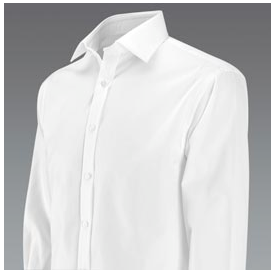
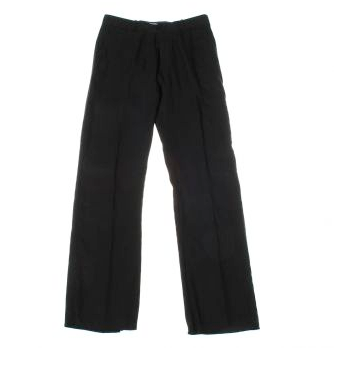
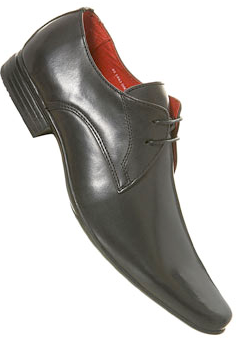
The killer, played by Jezz Eden, will be wearing a black jacket/coat with black trousers and black shoes.
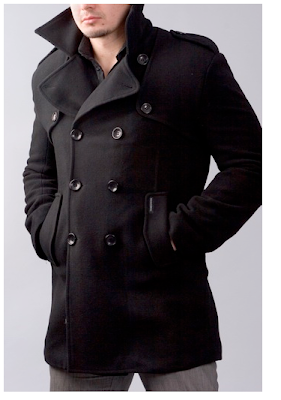
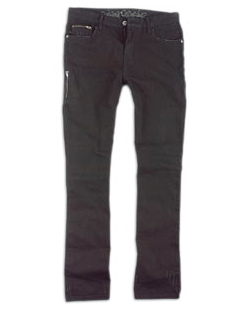

The victim, played by William Hall, will be wearing a black trench coat with black jeans and black shoes.
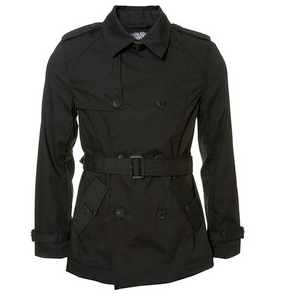
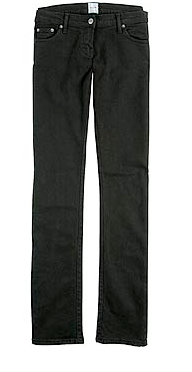
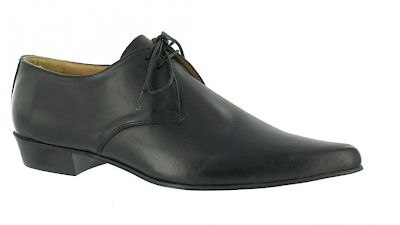
The detective, played by Thomas Edwards will be wearing a white shirt, with black trousers and black shoes.



The killer, played by Jezz Eden, will be wearing a black jacket/coat with black trousers and black shoes.



The victim, played by William Hall, will be wearing a black trench coat with black jeans and black shoes.



Certificate
Most thriller movies have a certificate of 15 years of age and over. Some, however not many are 18 and over and even some 12 certificates.
Our thriller is targeted for an audience of 15 years of age and over.
It is suited for both male and females aged between 15 and 30, due to the fact that they are the most likely audience to watch a thriller film.
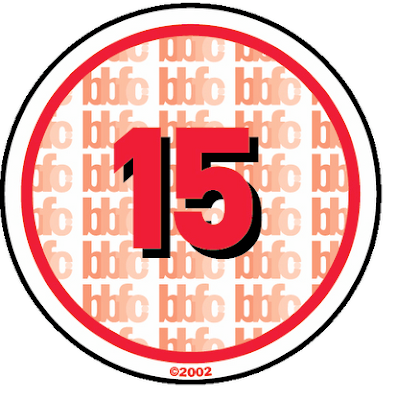
The 15 rating is only used for films shown in cinemas. It is given to films that are best suited to those aged 15 or older. We have chosen to have our certificate as a 15 as it is a psychological thriller meaning there will be some violence, explicit language and drug usage.
Our thriller is targeted for an audience of 15 years of age and over.
It is suited for both male and females aged between 15 and 30, due to the fact that they are the most likely audience to watch a thriller film.

The 15 rating is only used for films shown in cinemas. It is given to films that are best suited to those aged 15 or older. We have chosen to have our certificate as a 15 as it is a psychological thriller meaning there will be some violence, explicit language and drug usage.
Monday, 8 February 2010
FILM IDEA
our idea is a crime/psychological thriller.
-for one of the scenes, there will be a detective character in a dark room working on a wall trying to work out several deaths. he is standing up against the wall which is covered in writing and pictures of 'suspects', 'victims' and 'evidence'.
-the next scene is of a young man walking along, and being followed by someone, and in the scenes where you see this character, there is always the other person in the background.
-these scenes both cut from each other, with titles coming out from the wall between the parallel scenes.
-for one of the scenes, there will be a detective character in a dark room working on a wall trying to work out several deaths. he is standing up against the wall which is covered in writing and pictures of 'suspects', 'victims' and 'evidence'.
-the next scene is of a young man walking along, and being followed by someone, and in the scenes where you see this character, there is always the other person in the background.
-these scenes both cut from each other, with titles coming out from the wall between the parallel scenes.
Thursday, 4 February 2010
Practice Garageband

This is our Garageband project that we have started for our opening scene. We were inspired by the opening sequence from Se7en, because we believed that the opening had a very good impact on the movie as a whole, with a very dramatic choice of sounds used. We decided it would be best to take this on board and also produce a dramatic piece of music. We used electronic, atmospheric sounds to create a dramatic and erie feel within the music.
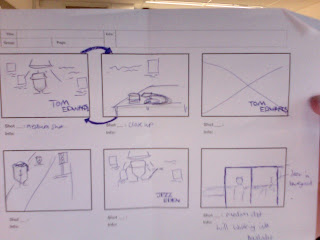
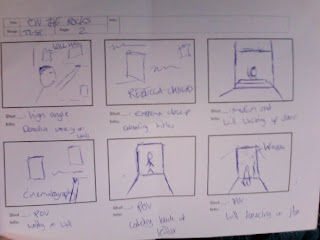
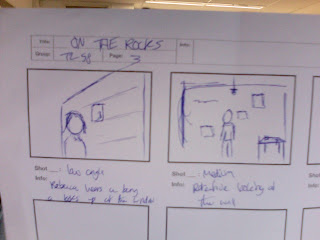
\

this is the first scene that shows a close up shot of the table with a tie thrown over it, a glass of whiskey and a cigarette in an ash tray.

the next shot is a medium shot of the detective character staring up at a wall covered in pictures and writing.

this is a close up and a reveal shot of the victim walking round a corner, with the murderer up on a bridge in the background.

in then goes back to the detective in the room writing more on the wall, and the titles come out from the wall.
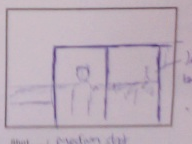
this is another medium shot showing the victim walk into travelodge once again showing the murderer in the background.
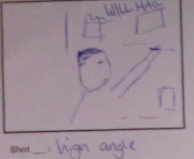
this is a high angle shot looking down at the detective writing on the wall

the high angle shot then cuts to an extreme close up of more titles emerging from the wall.

this is a medium shot seeing the victim walking up from the stairs
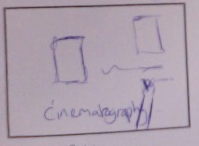
it then goes back to more titles emerging from the wall from a close up shot.

we then see a point of view (POV) shot from the victim seeing the murderer also walking up the stairs behind him.

its then a point of view from the murdere watching the victim lower and fall to his knees.

it then cuts to a low angle shot of random person outside played by Rebecca hearing a loud bang and looking around at travelodge.

the last shot is a long shot showing more titles and then the detective circling specific pictures and information on the wall.
Wednesday, 3 February 2010
TITLES
Monday, 1 February 2010
Mood Board
Subscribe to:
Comments (Atom)













